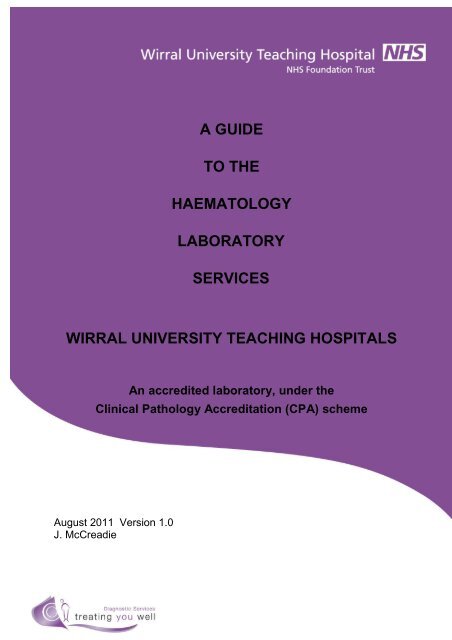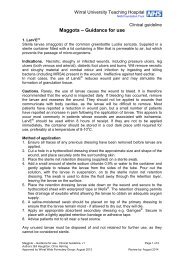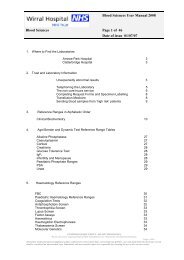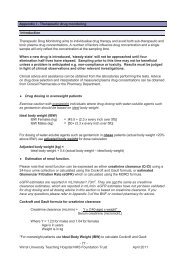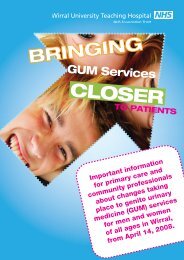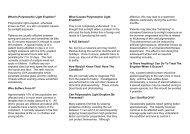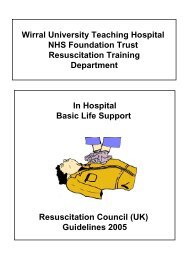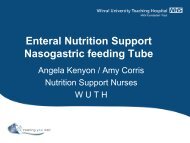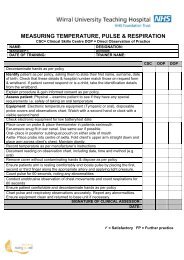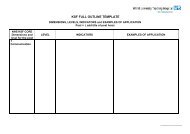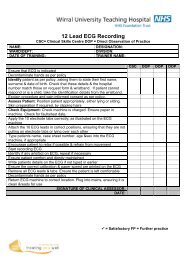a guide to the haematology laboratory services wirral
a guide to the haematology laboratory services wirral
a guide to the haematology laboratory services wirral
Create successful ePaper yourself
Turn your PDF publications into a flip-book with our unique Google optimized e-Paper software.
A GUIDE<br />
TO THE<br />
HAEMATOLOGY<br />
LABORATORY<br />
SERVICES<br />
WIRRAL UNIVERSITY TEACHING HOSPITALS<br />
An accredited labora<strong>to</strong>ry, under <strong>the</strong><br />
Clinical Pathology Accreditation (CPA) scheme<br />
August 2011 Version 1.0<br />
J. McCreadie<br />
CONTROLLED DOCUMENT – DO NOT PHOTOCOPY<br />
Wirral Hospital NHS Trust – Direc<strong>to</strong>rate of Labora<strong>to</strong>ry Medicine – Department of Microbiology<br />
Document printed on 10/08/2011 MM-POL-002 Version 2…. Page 1 of 24<br />
The his<strong>to</strong>ry of this document including <strong>the</strong> author, authoriser(s) and revision date can be found on Q-Pulse. Any copy made from <strong>the</strong> electronic version shall be considered an<br />
uncontrolled copy. Individuals with uncontrolled copies are responsible for ensuring <strong>the</strong> use of <strong>the</strong> current version.
CONTENTS<br />
1 General Information ...........................................................................................3<br />
Introduction................................................................................................................3<br />
Opening hours and contact numbers .......................................................................4<br />
BMS Out Of Hours Service for urgent tests .............................................................5<br />
2 Clinical advice.................................................................................................6<br />
3 Key contacts and <strong>the</strong>ir telephone numbers / extensions ...............................7<br />
4 Haema<strong>to</strong>logy - Principal Services.....................................................................8<br />
5 Requirements for request forms (PCIS, WROCS and Handwritten forms).10<br />
CERNER REQUESTING .......................................................................................11<br />
6 Labelling requirements for specimens...........................................................11<br />
7 Sample Availability...........................................................................................11<br />
8 Standard procedures for <strong>the</strong> safe collection of specimens..........................13<br />
9 Blood Collection Chart for Haema<strong>to</strong>logySGATHER EQUIPMENT................14<br />
10 Transport of clinical specimens <strong>to</strong> <strong>the</strong> Labora<strong>to</strong>ry .......................................15<br />
Specimens collected from Arrowe Park Hospital ...................................................15<br />
Specimens collected from GP Practices ................................................................15<br />
Packaging and transport ........................................................................................15<br />
11 Haema<strong>to</strong>logy tests and Turnaround Times....................................................16<br />
12. Key fac<strong>to</strong>rs which affect <strong>the</strong> performance and or result of a haema<strong>to</strong>logy<br />
Test...................................................................................................................20<br />
13 HAEMATOLOGY REFERENCE RANGES........................................................21<br />
2 – 7 Years................................................................................................................24<br />
8 – 14 Years..............................................................................................................24<br />
Coagulation............................................................................................................25<br />
14 Haema<strong>to</strong>logy Referral Labora<strong>to</strong>ries................................................................27<br />
Appendix 1 Location of Haema<strong>to</strong>logy Labora<strong>to</strong>ry at Arrowe Park Hospital<br />
Page
1 General Information<br />
Introduction<br />
Welcome <strong>to</strong> <strong>the</strong> Haema<strong>to</strong>logy Department User Manual of Wirral University Teaching<br />
Hospital NHS Foundation Trust (WUTH). The Haema<strong>to</strong>logy Department provides a<br />
wide range of consultative, analytical, teaching and developmental <strong>services</strong>. The<br />
department provides its <strong>services</strong> from 2 sites. The main department is located at<br />
Arrowe Park Hospital with a satellite essential <strong>services</strong> labora<strong>to</strong>ry located at<br />
Clatterbridge Centre for Oncology which is located on <strong>the</strong> Clatterbridge site.<br />
This user manual is designed <strong>to</strong> give an overview of <strong>services</strong> available in <strong>the</strong><br />
Department including <strong>the</strong> availability of clinical advice as well as <strong>the</strong> scope and<br />
limitations of <strong>the</strong> service. It is intended as a quick reference <strong>guide</strong> for all users, both<br />
within WUTH and primary and o<strong>the</strong>r secondary care health providers who use <strong>the</strong><br />
service. Results of labora<strong>to</strong>ry tests are made available <strong>to</strong> patients through <strong>the</strong>ir<br />
Clinicians or General Practitioners. The Haema<strong>to</strong>logy Department is accredited by<br />
Clinical Pathology Accreditation (UK) Ltd. In addition, <strong>the</strong> Transfusion service is<br />
regulated by Medicines and Healthcare Regula<strong>to</strong>ry Authority (MHRA). The service<br />
undergoes continuous review through quality assurance and audit activities<br />
A controlled electronic copy of this manual is available <strong>to</strong> all clinical areas and<br />
general practitioners within WUTH catchment area via <strong>the</strong> WUTH website:<br />
http://www.whnt.nhs.uk<br />
Information regarding labora<strong>to</strong>ry tests can be obtained by accessing labora<strong>to</strong>ry tests<br />
on line:<br />
Lab tests on line:<br />
http://www.labtestsonline.org.uk/<br />
Or by contacting <strong>the</strong> department directly:<br />
0151 678 5111 ext 2093<br />
Address for all correspondence:<br />
Arrowe Park Hospital<br />
Arrowe Park Road<br />
Up<strong>to</strong>n<br />
Wirral<br />
CH49 5PE<br />
Hospital telephone number 0151 678 5111<br />
Web address : http://www.whnt.nhs.uk
Opening hours and contact numbers<br />
OPENING HOURS AND CONTACT NUMBERS<br />
SECTION CORE HOURS CONTACT NUMBER<br />
Specimen Reception<br />
Mon – Fri 9am – 9pm<br />
Sat & Sun 9am - 5am<br />
0151 678 5111 ext 2104<br />
DDI 0151 604 7093<br />
Phlebo<strong>to</strong>my<br />
Haema<strong>to</strong>logy (APH)<br />
Haema<strong>to</strong>logy (CCO)<br />
Molecular Genetics<br />
Warfarin Moni<strong>to</strong>ring<br />
(WACS)<br />
Flow Cy<strong>to</strong>metry<br />
Transfusion<br />
Mon – Thurs 8.30am – 5.30pm<br />
Fri 8.30 – 5pm<br />
Sat & Sun 7.30am -11.30am<br />
(ward service only)<br />
Mon-Fri 9am – 5.30pm<br />
(except bank holidays)<br />
Mon-Fri 9am – 5.30pm<br />
(except bank holidays)<br />
Mon-Fri 9am – 5.30pm<br />
(except bank holidays)<br />
Mon-Fri 9am – 5.30pm<br />
(except bank holidays)<br />
Mon-Fri 9am – 5.30pm<br />
(except bank holidays)<br />
Mon-Fri 9am – 5.30pm<br />
(except bank holidays)<br />
For appointments:<br />
0151 678 5111 ext 2518<br />
DDI 0151 604 7382<br />
0151 678 5111 ext 2093<br />
0151 334 4000 ext 4519<br />
0151 678 5111 ext 2101<br />
0151 678 5111 ext 2536<br />
DDI 0151 604 7393<br />
FAX 0151 604 0370<br />
0151 678 5111 ext 2101<br />
0151 678 5111 ext 2100<br />
FAX 0151 604 0034<br />
Transfusion Practitioner<br />
Team<br />
Mon-Fri 9am – 5.30pm<br />
(except bank holidays)<br />
0151 678 5111 ext<br />
Bleep 2209
BMS Out Of Hours Service for urgent tests<br />
An out of hours service is available at Arrowe Park site outside of core hours.<br />
The service is accessed via <strong>the</strong> hospital bleep.<br />
All requests made during out of hours should be requested on HIS with an urgent<br />
priority. If a request form is used, <strong>the</strong> form should be marked URGENT and a contact<br />
telephone number where <strong>the</strong> result can be telephoned <strong>to</strong> must be provided.<br />
Bleep 2093<br />
Monday <strong>to</strong> Friday 17:30 <strong>to</strong> 09:00 following<br />
day<br />
Saturday / Sunday / 09:00 <strong>to</strong> 09:00 following<br />
Bank Holiday<br />
day<br />
There is at least 1 BMS is on duty throughout <strong>the</strong> out of hours period. All out of hours<br />
tests received during this period will be prioritized and processed. However, <strong>the</strong> BMS<br />
must be contacted if:<br />
• Request is for blood or blood products/components<br />
• Request is very urgent<br />
• Request for malarial parasite screening<br />
• Urgent ESR<br />
• Pre-operative sickle screen<br />
• Non- non core test requested<br />
Haema<strong>to</strong>logy out of hours test list<br />
For any o<strong>the</strong>r tests <strong>the</strong> on call consultant haema<strong>to</strong>logist must be contacted<br />
Transfusion<br />
Haema<strong>to</strong>logy<br />
Group & Antibody Screen<br />
Blood and blood product issue<br />
Group and Coombs<br />
Transfusion Reaction Investigation<br />
Kleihaur<br />
FBC<br />
Coagulation Screen<br />
INR<br />
APTT<br />
D-Dimer<br />
Malaria Screen<br />
ESR if:<br />
Suspected Temporal Arthritis<br />
Polymyalgia rheumatica<br />
Differential diagnosis of hip pain in children<br />
Sickle screen – Patients going for emergency <strong>the</strong>atre<br />
Only.
2 Clinical advice<br />
Clinical advice is available at all times.<br />
To contact a consultant haema<strong>to</strong>logist during core hours, 9am – 5.30pm Monday –<br />
Friday, contact <strong>the</strong> Consultant Haema<strong>to</strong>logists’ secretary. The individual telephone<br />
numbers are contained in section 3, Key contacts and <strong>the</strong>ir telephone numbers.<br />
To Contact <strong>the</strong> Consultant Haema<strong>to</strong>logist during non core hours, telephone Arrowe<br />
Park switchboard, telephone number 0151 678 5111 and ask <strong>to</strong> speak <strong>to</strong> <strong>the</strong><br />
Haema<strong>to</strong>logist on call.
3 Key contacts and <strong>the</strong>ir telephone numbers / extensions<br />
Members of staff are available on extension numbers during normal working hours<br />
via <strong>the</strong> Arrowe Park Hospital Switchboard, telephone number 0151 678 5111<br />
LOCATION / ROLE STAFF MEMBER INTERNAL EXTENSION<br />
Haema<strong>to</strong>logy / Coagulation Elaine Lup<strong>to</strong>n 2093 or 2834<br />
Warfarin Moni<strong>to</strong>ring:<br />
Dosing<br />
Clinic queries<br />
Keith Skinner<br />
Helen Woodward<br />
2536<br />
2536<br />
Molecular Genetics John Welbourn 2641<br />
Flow Cy<strong>to</strong>metry Paula Peppin 2101<br />
Transfusion David Goodridge 2100<br />
Lead Transfusion<br />
Practitioner<br />
David Goodridge 2209<br />
Bleep 2209<br />
Service Manager Julie McCreadie 2847<br />
Consultant Haema<strong>to</strong>logist<br />
Secretary<br />
Consultant Haema<strong>to</strong>logist<br />
Secretary<br />
Consultant Haema<strong>to</strong>logist<br />
Secretary<br />
Dr N Butt<br />
Pauline Sweeney-Jones<br />
Dr D Galvani<br />
Anne Whitehead<br />
Dr R Dasgupta<br />
Hazel Edwards<br />
2821<br />
DDI 0151 604 7105<br />
2105<br />
2089<br />
DDI 0151 604 7122<br />
2658<br />
8069<br />
DDI<br />
8456<br />
Pathology<br />
Clinical Direc<strong>to</strong>r<br />
Pathology<br />
Deputy ADO<br />
Dr M Lip<strong>to</strong>n 2982<br />
Margaret Shaughnessy 2095<br />
Phlebo<strong>to</strong>my Manager Jan Colligan 2032<br />
Specimen Reception<br />
Team Leader<br />
Dianne McLavery 2102
4 Haema<strong>to</strong>logy - Principal Services<br />
Clinical and Diagnostic Service<br />
The department offers a wide range of consultative, analytical, teaching and<br />
developmental <strong>services</strong>.<br />
The principal diagnostic labora<strong>to</strong>ry is based at Arrowe Park Hospital. In addition<br />
<strong>the</strong>re is a small essential <strong>services</strong> satellite labora<strong>to</strong>ry on <strong>the</strong> Clatterbridge site within<br />
<strong>the</strong> Clatterbridge Centre for Oncology building. Access <strong>to</strong> consultative and principal<br />
diagnostic <strong>services</strong> are available on a 24 hour basis. Advice on <strong>the</strong> selection of<br />
appropriate diagnostic specimens, <strong>the</strong>ir collection and transport is also available.<br />
Results of particular clinical significance are phoned through <strong>to</strong> <strong>the</strong> surgery, ward<br />
or relevant medical staff, irrespective of whe<strong>the</strong>r <strong>the</strong> original request is marked as<br />
urgent or routine.<br />
Consultative Services<br />
Consultant haema<strong>to</strong>logists are available for advice regarding clinical or labora<strong>to</strong>ry<br />
issues during office hours and provide an emergency only service out of hours via<br />
<strong>the</strong> switchboard at Arrowe Park Hospital.<br />
Significantly abnormal results are reviewed by a consultant haema<strong>to</strong>logist and results<br />
communicated <strong>to</strong> clinical staff <strong>to</strong> ensure rapid access for haema<strong>to</strong>logical opinion.<br />
In addition, Arrowe Park Hospital has a 7-day consultant-led clinical haema<strong>to</strong>logy unit<br />
for effectively managing both in- and out-patient haema<strong>to</strong>-oncology patients.<br />
Consultant Haema<strong>to</strong>logists also deliver general haema<strong>to</strong>logy clinics and<br />
anticoagulant clinics in an out-patient setting.<br />
As well as general haema<strong>to</strong>logy interests, <strong>the</strong> Consultant Haema<strong>to</strong>logists also take a<br />
pro-active lead in <strong>the</strong> specialist areas of transfusion, anticoagulation, thalassaemia<br />
and haemoglobinopathy investigations and cancer.<br />
Analytical Services<br />
In addition <strong>to</strong> routine haema<strong>to</strong>logy, coagulation and transfusion labora<strong>to</strong>ry <strong>services</strong>,<br />
<strong>the</strong> department also delivers a range of haema<strong>to</strong>logical molecular genetic and flow<br />
cy<strong>to</strong>metry tests. The department is fully-au<strong>to</strong>mated <strong>to</strong> ensure it delivers a timely<br />
service <strong>to</strong> support patient care. In addition <strong>to</strong> its routine service, it provides an out of<br />
hour’s service delivering rapid turnaround of out of hours tests for primary and<br />
secondary care.<br />
All test results validated by a full programme of both internal and external quality<br />
assurance procedures.
Teaching<br />
The department is an IBMS approved training labora<strong>to</strong>ry for pre-registration<br />
Biomedical Scientists and specialist training in Haema<strong>to</strong>logy with Hospital<br />
Transfusion Practice.<br />
It supports <strong>the</strong> training of undergraduate and postgraduate medical students and<br />
undergraduate BMS students and has developed close links with <strong>the</strong> local<br />
universities. It is also actively involved in providing work experience for year 12 and<br />
13 pupils from local schools. All training in <strong>the</strong> department is supported by <strong>the</strong><br />
departmental training co-coordina<strong>to</strong>r.<br />
Audit<br />
To ensure a process of continuous improvement, <strong>the</strong> department has an internal<br />
monthly audit schedule which examines all areas of department performance. The<br />
department also participates in national audits in order <strong>to</strong> bench mark its<br />
performance and ensure best practice compliance. The audit programme is<br />
supported by <strong>the</strong> departmental quality lead.<br />
Research and Development<br />
The department has an active research and development programme in several<br />
areas, especially molecular genetics and flow cy<strong>to</strong>metry.<br />
The clinical haema<strong>to</strong>logy unit is actively involved in clinical trials and is supported in<br />
this role by a specialist haema<strong>to</strong>logy research nurse.<br />
The Transfusion Practitioner Team supports transfusion development and patient<br />
safety issues.<br />
All medical and technical staff participate in CPD. Technical staff are required <strong>to</strong><br />
maintain a professional portfolio.<br />
Our readily accessible clinical and labora<strong>to</strong>ry staff are glad <strong>to</strong> answer any questions<br />
and offer advice.
Document control<br />
All documents used in Haema<strong>to</strong>logy are managed electronically using Q-Pulse<br />
software (Q-Pulse Version 5 Gael Quality Limited).<br />
Documents are embedded within <strong>the</strong> system and backed up on WHIS Servers <strong>to</strong><br />
protect <strong>the</strong>ir integrity.<br />
There are policies, procedures and templates specific <strong>to</strong> Haema<strong>to</strong>logy as well as<br />
shared direc<strong>to</strong>rate documents.<br />
The department and Direc<strong>to</strong>rate of Labora<strong>to</strong>ry Medicine are obliged <strong>to</strong> follow Trust<br />
policy and procedures. To avoid duplication some of <strong>the</strong>se policy and procedure<br />
documents are used in place of departmental ones.<br />
Trust policies and procedures are located on <strong>the</strong> intranet.<br />
5 Requirements for request forms (PCIS, WROCS and<br />
Handwritten forms)<br />
Requests communicated <strong>to</strong> <strong>the</strong> labora<strong>to</strong>ry are as follows<br />
PCIS forms generated at ward level<br />
WROCS forms generated by <strong>the</strong> GP practises<br />
Hand written ‘Red forms’<br />
Individual GP request forms<br />
All verbal requests <strong>to</strong> <strong>the</strong> labora<strong>to</strong>ry must be accompanied by one of <strong>the</strong> above request<br />
forms for <strong>the</strong> test <strong>to</strong> proceed.<br />
HOSPITAL WARDS AND DEPARTMENTS<br />
All requests for haema<strong>to</strong>logy tests should be made electronically on <strong>the</strong> Hospital<br />
Information System (HIS). Once a request has been made <strong>the</strong> appropriate request<br />
documentation will be generated. This will be ei<strong>the</strong>r a request form (PCIS request) or<br />
a sample label (CERNER request).<br />
In <strong>the</strong> event of HIS downtime, downtime request forms provided by WHIS must be<br />
used. The essential information required, as detailed in <strong>the</strong> table below, MUST be<br />
completed.<br />
GENERAL PRACTITIONERS<br />
All requests for haema<strong>to</strong>logy tests should be made electronically on Wirral Remote<br />
Order Communications System (WROCS). In <strong>the</strong> event of WROCS downtime, paper<br />
request forms ei<strong>the</strong>r provided by or approved by <strong>the</strong> labora<strong>to</strong>ry MUST be completed.<br />
A request form must accompany all specimens sent <strong>to</strong> <strong>the</strong> labora<strong>to</strong>ry using WROCS or<br />
PCIS patient ordering systems. It should clearly state <strong>the</strong> following information for<br />
unequivocal identification of <strong>the</strong> patient and specimen:
• Patient name (in full – no abbreviations)<br />
• Ward, Clinic, or GP name and number/ address<br />
• NHS number<br />
• Date of Birth (ra<strong>the</strong>r than age, if possible)<br />
• Sex<br />
• Type of specimen<br />
Date and time specimen taken<br />
The ONLY exception where a request form is NOT requires is a request for an INR<br />
for anticoagulant moni<strong>to</strong>ring via WACS. In this event, <strong>the</strong> patients’ OAT book (Oral<br />
Anticoagulant Therapy ‘yellow book’) serves as <strong>the</strong> request form.<br />
It is ESSENTIAL that <strong>the</strong> labora<strong>to</strong>ry knows <strong>the</strong> date on which a specimen is taken as<br />
processing delayed specimens can yield unhelpful or frankly misleading results. In<br />
addition if a request for malarial parasite screening is made, all relevant clinical details,<br />
prophylaxis treatment and his<strong>to</strong>ry of foreign travel is required.<br />
CERNER REQUESTING<br />
CERNER is a hospital paperless system that will not generate a request form EXCEPT<br />
for transfusion requests. All CERNER requests should have a status collected in<br />
CERNER. The specimens should be sent with <strong>the</strong> printed label on <strong>the</strong> specimen. All of<br />
<strong>the</strong> above details are necessary <strong>to</strong> include when making a CERNER request.<br />
6 Labelling requirements for specimens<br />
• The specimen must be labelled with <strong>the</strong> patient details as on <strong>the</strong> request form.<br />
• The specimen must be labelled with <strong>the</strong> date of collection.<br />
• Please note that unlabelled, inadequately labelled or mislabelled specimens cannot<br />
be processed and will be discarded.<br />
The criterion for sample acceptance is described in Wirral University Teaching<br />
Hospital NHS Foundation Trusts Standard for Labelling of Labora<strong>to</strong>ry Specimens<br />
Policy, policy reference number 044. The criterion for blood transfusion sample<br />
acceptance is also detailed in Blood Transfusion Policy, policy reference number<br />
019. This is strictly adhered <strong>to</strong> in <strong>the</strong> interest of patient safety<br />
If <strong>the</strong> labora<strong>to</strong>ry cannot unequivocally identify <strong>the</strong> sample and match it <strong>to</strong> a form,<br />
<strong>the</strong>n it will be discarded.<br />
The labora<strong>to</strong>ry will inform senders by means of an electronic or printed report when a<br />
specimen has been discarded for <strong>the</strong> above reasons.<br />
7 Sample Availability
In certain circumstances it may be possible <strong>to</strong> add tests <strong>to</strong> samples that <strong>the</strong><br />
labora<strong>to</strong>ry has already received.<br />
The table below indicates how long samples are kept in <strong>the</strong> labora<strong>to</strong>ry before<br />
disposal.<br />
Requests for extra tests must be received within <strong>the</strong> sample s<strong>to</strong>rage period and must<br />
be accompanied by a request form. Please telephone <strong>the</strong> labora<strong>to</strong>ry before<br />
requesting extra tests <strong>to</strong> ensure <strong>the</strong> sample is available and still viable.<br />
Sample<br />
FBC<br />
Coagulation<br />
Molecular Genetics<br />
Blood Transfusion<br />
Flow Cy<strong>to</strong>metry<br />
Minimum sample retention time post<br />
analysis and S<strong>to</strong>rage condition<br />
48 hours @ room temperature<br />
24 hours @ room temperature<br />
whole blood sample:1 month @ 2-8°c<br />
DNA: 10 years @ 2-8°c<br />
7days @ 2-8°c<br />
Peripheral blood 7 days @ room temperature<br />
Bone marrow 5 weeks @ 2-8°c
8 Standard procedures for <strong>the</strong> safe collection of<br />
specimens<br />
These procedures concern all clinical staff, who are qualified and have been deemed<br />
competent <strong>to</strong> collect diagnostic specimens from patients.<br />
N.B. Staff must always follow aseptic techniques when handling blood, body fluids, excretions, or<br />
secretions, even when <strong>the</strong>se have not been specified as infectious.<br />
Objectives<br />
All staff must be aware of <strong>the</strong> potential physical and infectious hazards, associated<br />
with <strong>the</strong>se procedures, and should <strong>the</strong>refore collect specimens:<br />
1 being mindful of personal safety, without injury or exposure of <strong>the</strong>mselves and<br />
2 of collective safety, without exposing colleagues who are involved with <strong>the</strong><br />
handling, transport and labora<strong>to</strong>ry investigations of specimens, <strong>to</strong> physical or<br />
infectious hazards.<br />
Staff collecting specimens must take care <strong>to</strong> prevent contaminating <strong>the</strong>mselves,<br />
<strong>the</strong>ir environment, <strong>the</strong> external surfaces of <strong>the</strong> specimen containers, or <strong>the</strong><br />
accompanying test request forms. If gross contamination of <strong>the</strong> hands with<br />
blood, faeces or o<strong>the</strong>r biological fluids is anticipated, <strong>the</strong>n gloves should be<br />
worn. Hands should always be washed after taking specimens. If splashing in<strong>to</strong><br />
<strong>the</strong> eyes or on <strong>to</strong> mucous membranes is anticipated goggles should be worn.<br />
3 In addition, specimens should be collected aseptically, without allowing<br />
contamination by extraneous and, <strong>the</strong>refore, irrelevant micro-organisms.<br />
Contaminated specimens can adversely affect <strong>the</strong> validity of many labora<strong>to</strong>ry<br />
results. For example, <strong>the</strong> microbiological investigation of contaminated blood or<br />
o<strong>the</strong>r materials from sites, which are normally sterile, can commit patients <strong>to</strong><br />
unwarranted courses of expensive and potentially <strong>to</strong>xic treatment.<br />
Before you start<br />
1 Ensure that <strong>the</strong> lighting conditions are adequate.<br />
2 Select <strong>the</strong> correct specimen container(s) (see Quick Guide in Section 10),<br />
appropriate for <strong>the</strong> type of specimen, and keep <strong>the</strong> container close <strong>to</strong> <strong>the</strong> site<br />
from which <strong>the</strong> specimen is <strong>to</strong> be obtained.<br />
3 Complete, legibly and fully, all sections of <strong>the</strong> label on <strong>the</strong> specimen container<br />
and, check <strong>the</strong> details on <strong>the</strong> computer generated request form from WROCS is<br />
correct or, where used, <strong>the</strong> colour-coded test request forms.<br />
4 If you suspect, or are aware of, an infection with a Hazard Group 3 pathogen<br />
(examples of relatively common Hazard Group 3 pathogens are Hepatitis B<br />
virus, Human Immunodeficiency virus and Mycobacterium tuberculosis), this<br />
must be mentioned in <strong>the</strong> clinical details sent with <strong>the</strong> specimen.<br />
5 If you suspect, or are aware of, an infection with a Hazard Group 4 pathogen<br />
(Viral haemorrhagic fevers, eg Ebola and Lassa) do not attempt <strong>to</strong> collect any<br />
specimen. Inform <strong>the</strong> Infection Control Doc<strong>to</strong>r at once on extension 4512.
When you have finished<br />
All waste generated from obtaining a specimen should be disposed of according <strong>to</strong><br />
Local Waste Disposal Pro<strong>to</strong>cols.<br />
9 Blood Collection Chart for Haema<strong>to</strong>logySGATHER EQUIPMENT.<br />
PARE EQTEP 3: SKIN PREPARATION.<br />
VACUETTE ® SELECTION CHART<br />
Rec Cap Tube Tests Special Re-order<br />
Filling Colour Type Instructions Part<br />
Order<br />
Number<br />
1st<br />
Clotting<br />
Accelera<strong>to</strong>r<br />
B12, folate, ferritin, Paul Bunnell,<br />
hap<strong>to</strong>globins, anticardiolipin<br />
Aantibodies<br />
KFK059<br />
1st<br />
Clotting<br />
Accelera<strong>to</strong>r<br />
INR, clotting screen, APTT,D-<br />
Dimer, Lupus Anticoagulant,<br />
Thrombophilia screen (part of),<br />
Von Willebrands screen, fac<strong>to</strong>r<br />
assays, anti Xa<br />
Blood must<br />
be collected<br />
<strong>to</strong> <strong>the</strong><br />
volume<br />
specified<br />
on <strong>the</strong> tube<br />
KFK22<br />
5<br />
1st<br />
Clotting<br />
Accelera<strong>to</strong>r<br />
Separation<br />
Gel<br />
FBC, ESR, Paul Bunnell,<br />
malarial screen, plasma<br />
viscosity, sickle screen,<br />
thalassaemia screen, klieihaur,<br />
thrombophilia screen (part of),<br />
molecular genetics<br />
Mix 6 times.<br />
Separate<br />
sample<br />
KFK22<br />
4<br />
1st<br />
Clotting<br />
Accelera<strong>to</strong>r<br />
Separation<br />
Gel<br />
Group and save / Crossmatch<br />
KFK26<br />
5<br />
Samples for blood transfusion MUST be hand written<br />
Thrombophilia screening requires 3 blue bottles, 1 lavender<br />
bottle and 1 pink bottle<br />
If <strong>the</strong> test you are requesting is not on this list please contact <strong>the</strong>
10 Transport of clinical specimens <strong>to</strong> <strong>the</strong> Labora<strong>to</strong>ry<br />
Specimens collected from Arrowe Park Hospital<br />
Monday <strong>to</strong> Friday<br />
From 9.00 am until 2.00 p.m. daily <strong>the</strong>re is an hourly<br />
collection of pathology specimens from wards by <strong>the</strong> portering<br />
staff,<br />
After 2.00 p.m., bleep porters on bleep 2074 <strong>to</strong> pick up<br />
specimens Alternatively, samples maybe sent <strong>to</strong> <strong>the</strong><br />
labora<strong>to</strong>ry via <strong>the</strong> air tube system (pod) which has stations in<br />
various locations around <strong>the</strong> Arrowe Park site.<br />
Weekends and Bank holidays There are no scheduled collections for pathology<br />
samples on weekends or bank holiday. To arrange sample<br />
collection by a porter, bleep 2074. Alternatively samples<br />
maybe sent <strong>to</strong> <strong>the</strong> labora<strong>to</strong>ry via <strong>the</strong> air tube system.<br />
Specimens collected from GP Practices<br />
MCS Courier Services provide collection of specimens from General Practice for<br />
Labora<strong>to</strong>ry Medicine Monday <strong>to</strong> Friday only.<br />
Packaging and transport<br />
Before <strong>the</strong> specimens are collected by Porters, Couriers, Volunteers, Nursing and<br />
Support staff ensure that specimens and request forms are placed correctly in<strong>to</strong> <strong>the</strong><br />
mini-grip plastic bags. Specimens should be placed in <strong>the</strong> pocket of <strong>the</strong> plastic bag<br />
and grip seal sealed. The request form should be slid in<strong>to</strong> <strong>the</strong> sleeve of <strong>the</strong> plastic<br />
bag. The specimen should <strong>the</strong>n be placed in <strong>the</strong> large Pathology specimen bag for<br />
collection. If <strong>the</strong>re is <strong>to</strong> be a delay in transporting <strong>the</strong> sample <strong>to</strong> <strong>the</strong> labora<strong>to</strong>ry,<br />
advice from <strong>the</strong> labora<strong>to</strong>ry regarding appropriate s<strong>to</strong>rage should be sought.<br />
Specimens that are <strong>to</strong> be transported by taxi should be placed in a specimen tin or<br />
sealed in an large envelope.<br />
N.B.<br />
The plastic transport bags, if properly sealed, are designed <strong>to</strong> contain accidental specimen<br />
leakage from <strong>the</strong> container. Spontaneous specimen discharge, due <strong>to</strong> defective materials, is<br />
rare. Most incidents of specimen leakage are due <strong>to</strong> <strong>the</strong> fact that nei<strong>the</strong>r <strong>the</strong> container nor <strong>the</strong><br />
integral bag strips have been closed properly. If both container and transport bag are closed<br />
correctly, <strong>the</strong> practice of 'double-bagging', even when an infection with a Hazard Group 3<br />
pathogen is suspected, does not confer any additional safety advantage and is, <strong>the</strong>refore,<br />
unnecessary<br />
The containers supplied, comply with standards BS 4851 and BS 5213 for leakage and<br />
spontaneous discharge. Leaked containers frequently result in irreplaceable loss of specimens<br />
and, equally as important, staff <strong>to</strong> unwarranted hazards of infection.<br />
Members of <strong>the</strong> public who come across specimen tins containing specimens should<br />
follow <strong>the</strong> instructions printed on <strong>the</strong> tin.
11 Haema<strong>to</strong>logy tests and Turnaround Times<br />
All turn around times are stated in working days<br />
Turnaround time is defined as time from receipt in labora<strong>to</strong>ry <strong>to</strong> result<br />
released<br />
Working days – Monday – Friday 9am – 5.30pm<br />
Test / investigation Container and comments Turnaround<br />
Times<br />
FBC<br />
Adult - 4 ml LAVENDER EDTA<br />
Paediatric – 1.3ml EDTA<br />
Routine 4 hrs<br />
Urgent 2hrs<br />
ESR 4 ml LAVENDER EDTA Routine 4 hrs<br />
Urgent 1hr<br />
Reticulocytes 4 ml LAVENDER EDTA Routine 4 hrs<br />
Urgent 2hrs<br />
Blood film 4 ml LAVENDER EDTA 48 hrs<br />
Malarial parasite screen 4 ml LAVENDER EDTA initial report within<br />
2 hrs<br />
Plasma viscosity 4 ml LAVENDER EDTA 2 working days<br />
Paul Bunnell 4 ml LAVENDER EDTA 4 hrs<br />
INR 3.5ml BLUE Trisodium citrate Routine 4 hrs<br />
Urgent 2hrs<br />
APTT 3.5ml BLUE Trisodium citrate Routine 4 hrs<br />
Urgent 2hrs<br />
Clotting screen<br />
3.5ml BLUE Trisodium citrate<br />
Routine 4 hrs<br />
Urgent 2hrs<br />
D-Dimer 3.5ml BLUE Trisodium citrate Routine 4 hrs<br />
Urgent 2hrs<br />
Thrombophilia screen<br />
3.5ml BLUE Trisodium citrate<br />
5 working days<br />
4 ml LAVENDER EDTA<br />
4 ml OCHRE
Test / investigation Container and comments Turnaround<br />
Times<br />
Von Willebrands screen 3.5ml BLUE Trisodium citrate 5 working days<br />
treatment plan<br />
2hrs<br />
Lupus anticoagulant 3.5ml BLUE Trisodium citrate 5 working days<br />
Fac<strong>to</strong>r assays 3.5ml BLUE Trisodium citrate 5 working days<br />
treatment plan<br />
2hrs<br />
Cell markers<br />
4 ml LAVENDER EDTA<br />
7 days<br />
This test requires a separate container<br />
verbal result for<br />
urgent samples<br />
2hrs<br />
Bone Marrow<br />
Trephine and aspirate<br />
4 ml LAVENDER EDTA 10 working days<br />
Human Leukocyte Antigen (HLA)<br />
4 ml LAVENDER EDTA<br />
10 working days<br />
This test requires a separate container<br />
CD4 4 ml LAVENDER EDTA 5 working days<br />
Thalassaemia screen<br />
4 ml LAVENDER EDTA<br />
This test requires a separate container<br />
3 working days<br />
Sickle screen 4 ml LAVENDER EDTA Routine 3 working<br />
days<br />
Urgent 2 hours<br />
Confirmation of abnormal Hb /<br />
thalassaemia<br />
P2010A gene<br />
HFE gene<br />
JAK mutation<br />
4 ml LAVENDER EDTA<br />
This test requires a separate container<br />
4 ml LAVENDER EDTA<br />
This test requires a separate container<br />
4 ml LAVENDER EDTA<br />
This test requires a separate container<br />
4 ml LAVENDER EDTA<br />
This test requires a separate container<br />
4 weeks<br />
90% of all<br />
samples within 2<br />
weeks<br />
90% of all<br />
samples within 2<br />
weeks<br />
90% of all<br />
samples within 2
Test / investigation Container and comments Turnaround<br />
Times<br />
weeks<br />
9:22 screen 4 ml LAVENDER EDTA<br />
This test requires a separate container<br />
90% of all<br />
samples within 4<br />
weeks<br />
BCR-Abl<br />
FVLeiden<br />
4 ml LAVENDER EDTA<br />
This test requires a separate container<br />
4 ml LAVENDER EDTA<br />
This test requires a separate container<br />
90% of all<br />
samples within 4<br />
weeks<br />
90% of all<br />
samples within 2<br />
weeks<br />
B12 4 ml LAVENDER EDTA 4 hrs<br />
Folate 4 ml OCHRE 4 hrs<br />
Ferriritn 4 ml OCHRE 4 hrs<br />
Hap<strong>to</strong>globins 4 ml OCHRE 4 hrs<br />
Erythropoeitin<br />
Anti Xa<br />
4 ml OCHRE<br />
This test requires a separate container<br />
3.5ml BLUE Trisodium citrate<br />
This test requires a separate container<br />
7 working days<br />
5 working days<br />
HIT screen<br />
3.5ml BLUE Trisodium citrate<br />
This test requires a separate container<br />
5 working days<br />
G6PD 4 ml LAVENDER EDTA 4 working days<br />
Group and save 6ml PINK EDTA Routine 4 hrs<br />
Urgent 1hr<br />
Direct Coombs test 6ml PINK EDTA 4 hours<br />
Group and Coombs test Cord blood – 6ml PINK EDTA Routine 4 hrs
Test / investigation Container and comments Turnaround<br />
Times<br />
Capillary sample – 1.3ml EDTA<br />
Urgent 1hr<br />
Kleihaur 4 ml LAVENDER EDTA 48 hrs<br />
Transfusion reaction investigation<br />
Haem-oncology Cy<strong>to</strong>genetics<br />
HLA B27<br />
6ml PINK EDTA<br />
4 ml LAVENDER EDTA<br />
Urine sample<br />
Bone marrow transport media<br />
available from labora<strong>to</strong>ry<br />
4 ml LAVENDER EDTA<br />
This test requires a separate container<br />
4 hours<br />
Routine 3 weeks<br />
Urgent 10 days<br />
90% of all<br />
samples within 2<br />
weeks<br />
Specimens should be transported and processed as soon as possible.
12. Key fac<strong>to</strong>rs which affect <strong>the</strong> performance and or result<br />
of a haema<strong>to</strong>logy Test<br />
<br />
<br />
<br />
<br />
<br />
<br />
<br />
<br />
The technical competency, bias and experience of <strong>the</strong> staff performing <strong>the</strong><br />
test.<br />
The patient sample, how it is taken, s<strong>to</strong>red and transported <strong>to</strong> <strong>the</strong> labora<strong>to</strong>ry<br />
Delayed sample delivery <strong>to</strong> <strong>the</strong> labora<strong>to</strong>ry<br />
Clotted or partially clotted sample for a test which requires whole blood or<br />
plasma<br />
Sample collected in<strong>to</strong> an incorrect container<br />
Dilution of <strong>the</strong> sample if <strong>the</strong> sample is taken from a drip arm<br />
Expelling <strong>the</strong> sample through a needle in<strong>to</strong> <strong>the</strong> sample container or over<br />
vigorous mixing resulting in haemolysis<br />
Sample taken after a fatty meal or from a patient receiving intra-lipid resulting<br />
in a lipaemic sample
13 HAEMATOLOGY REFERENCE RANGES<br />
TEST<br />
FBC<br />
Adult<br />
Reference<br />
Range<br />
Units<br />
Remarks<br />
WCC 3.5 – 11.0 x 10 9 /L Male/Female<br />
RCC 4.25 – 5.55<br />
3.80 – 4.85<br />
Haemoglobin 13.0 – 16.6<br />
11.2 – 14.8<br />
RDW 11.7 – 13.7<br />
11.4 – 14.6<br />
Haema<strong>to</strong>crit 0.385 – 0.490<br />
0.340 – 0.450<br />
MCV 80 – 100<br />
80 – 100<br />
MCH 28.1 – 32.1<br />
26.2 – 33.8<br />
MCHC 32.2 – 35.4<br />
31.3 – 34.9<br />
x 10 12 /L<br />
g/dl<br />
ratio<br />
fl<br />
pg<br />
g/dl<br />
Male<br />
Female<br />
Male<br />
Female<br />
Male<br />
Female<br />
Male<br />
Female<br />
Male<br />
Female<br />
Male<br />
Female<br />
Male<br />
Female<br />
# Neutrophil 1.8 – 8.0 x 10 9 /L Male/Female<br />
# Lymphocyte 0.6 – 4.4 x 10 9 /L Male/Female<br />
# Monoytes 0 – 0.9 x 10 9 /L Male/Female<br />
# Eosinophils 0 – 0.6 x 10 9 /L Male/Female<br />
0 – 0.6<br />
# Basophils 0 – 0.4 x 10 9 /L Male/Female<br />
Platelets 150 – 400 x 10 9 /L Male/Female
TEST<br />
Adult<br />
Reference<br />
Range<br />
ESR 1 – 15<br />
1 – 20<br />
Units<br />
mm/h<br />
Plasma Viscosity 1.50 – 1.72 mPas<br />
Reticulocytes 0.2 – 2.0%<br />
Remarks<br />
Male<br />
Female<br />
Note - Increases with age<br />
Blood Film<br />
(associated with<br />
FBC)<br />
Interpretative cy<strong>to</strong>logy report.<br />
Relevant clinical data must be<br />
provided when requested.<br />
Paul Bunnell N/A Screening test for Glandular<br />
Fever<br />
Malarial Parasites N/A Labora<strong>to</strong>ry must be contacted,<br />
area of travel, prophylaxis and<br />
symp<strong>to</strong>ms must be provided.
Paediatric haema<strong>to</strong>logy reference ranges<br />
Source: Alder Hey Children’s Hospital<br />
Neonate:<br />
Parameter Units 1 Day 3 Days 2 Weeks 1 Month 2 Months<br />
WCC x 10 9 /L 9.0 – 18.4 9.0 – 18.4 5.0 – 18.0 5.0 – 18.0 5.0 – 18.0<br />
RCC x 10 12 /L 3.80 – 6.50 3.80 – 6.50 3.2 – 6.4 2.80 – 5.30 2.60 – 4.30<br />
Hb g/dl 14.0 – 22.0 14.0 – 22.0 12.5 – 20.5 10.0 – 17.0 9.0 – 13.5<br />
Hct Ratio 0.450 – 0.670 0.450 – 0.670 0.39 – 0.63 0.310 – 0.550 0.280 – 0.420<br />
MCV Fl 98 – 130 94 – 130 86 – 120 85 – 120 77 – 115<br />
MCH Pg 31.0 – 39.0 30.0 – 37.0 28.0 – 37.0 27.0 – 36.0 26.0 – 34.0<br />
MCHC g/dl 30.0 – 36.0 30.0 – 36.0 28.0 – 36.5 29.0 – 36.5 29.0 – 36.5<br />
Neutrophil x 10 9 /L 4.8 – 17.2 2.0 – 9.4 1.7 – 6.0 1.0 – 9.0 1.0 – 9.0<br />
Lymphocyte x 10 9 /L 2.0 – 7.3 2.0 – 7.3 2.8 – 9.1 3.0 – 13.5 3.0 – 13.5<br />
Monocyte x 10 9 /L 0.1 – 1.9 0.1 – 1.9 0.1 – 1.7 0.1 – 1.7 0.1 – 1.7<br />
Eosinophil x 10 9 /L 0 – 0.9 0 – 0.8 0 – 0.8 0 – 0.8 0 – 0.8<br />
Basophil x 10 9 /L 0 – 0.2 0 – 0.2 0 – 0.2 0 – 0.2 0 – 0.2<br />
Platelets x 10 9 /L 150 – 400 150 – 400 150 - 400 150 – 400 150 – 400
Paediatric haema<strong>to</strong>logy reference ranges<br />
Source: Alder Hey Children’s Hospital<br />
Child:<br />
Parameter Units 6 Months 1 Year 2 Years 2 – 7 Years 8 – 14 Years<br />
WCC x 10 9 /L 5.0 – 17.0 5.0 – 17.0 5.0 – 17.0 6.3 – 16.2 4.9 – 13.7<br />
RCC x 10 12 /L 3.6 – 5.0 4.3 – 5.3 4.0 – 5.0 4.00 – 5.00 4.00 – 5.20<br />
Hb g/dl 10.0 – 14.3 10.0 – 14.1 10.0 – 14.8 10.0 – 14.8 11.5 – 15.8<br />
Hct Ratio 0.300 – 0.430 0.300 – 0.410 0.310 – 0.430 0.310 – 0.430 0.34 – 0.470<br />
MCV Fl 72 – 95 73 – 92 73 – 90 74 – 88 76 – 92<br />
MCH Pg 25.0 – 33.0 24.0 – 32.0 23.0 – 32.0 25.0 – 32.0 25.0 – 33.0<br />
MCHC g/dl 30.0 – 36.0 30.0 – 36.0 30.0 – 36.0 31.0 – 36.0 31.0 – 36.0<br />
Neutrophil x 10 9 /L 1.0 – 8.5 1.5 – 8.5 1.5 – 8.5 1.6 – 9.0 1.4 – 7.5<br />
Lymphocyte x 10 9 /L 4.0 – 13.5 4.0 – 10.5 3.0 – 9.5 2.2 – 9.8 1.9 – 7.6<br />
Monocyte x 10 9 /L 0.1 – 1.3 0.1 – 1.3 0.1 – 1.3 0.1 – 1.3 0.1 – 1.3<br />
Eosinophil x 10 9 /L 0 – 0.8 0 – 0.8 0 – 0.8 0 – 0.8 0 – 0.75<br />
Basophil x 10 9 /L 0 – 0.2 0 – 0.2 0 – 0.2 0 – 0.2 0 – 0.2<br />
Platelets x 10 9 /L 150 - 400 150 – 400 150 – 400 150 – 400 150 – 400
Coagulation<br />
Test Adult Reference Range Remarks<br />
INR 0.9 – 1.2<br />
APTT<br />
Fibrinogen<br />
Clotting Screen<br />
23 – 39 secs<br />
1.5 – 4.5 g/L<br />
Comprises: INR, APTT and fibrinogen<br />
D-Dimer < 200 ng/ml Performed for query DVT and PE<br />
only<br />
Protein C 70 – 150% Affected by oral anticoagulant,<br />
pregnancy and current thrombotic<br />
events<br />
Protein S 60 – 140% Affected by oral anticoagulant,<br />
pregnancy and current thrombotic<br />
events<br />
Antithrombin III 85 – 120% Invalid for heparin treatment<br />
Von Willebrand<br />
screen<br />
Lupus<br />
Anticoagulant<br />
Thrombophilia<br />
Screen<br />
Fac<strong>to</strong>r II 60 – 160%<br />
Fac<strong>to</strong>r V 70 – 150%<br />
Fac<strong>to</strong>r VII 60 – 160%<br />
Fac<strong>to</strong>r VIII 50 – 150%<br />
Fac<strong>to</strong>r VIII Rag 50 – 200%<br />
Fac<strong>to</strong>r IX 55 – 150%<br />
Fac<strong>to</strong>r X 60 – 120%<br />
Fac<strong>to</strong>r XI 55 – 150%<br />
Fac<strong>to</strong>r XII 56 – 140%<br />
VIIIRICoF 50 – 150%<br />
Serum B12<br />
Serum Folate<br />
Interpretative report.<br />
0.9 – 1.2 Ratio Interpretative report.<br />
223 – 1132 ng/L<br />
2.8 – 18.6 ug/L<br />
Interpretative report.
Test Adult Reference Range Remarks<br />
Serum Ferritin 30 – 284 ug/L Male<br />
“ 6 – 81 ug/L Female under 46 years<br />
“ 14 – 186 ug/L Female over 45 years<br />
Thalassaemia<br />
Screen<br />
Hb F 0 – 0.8%<br />
Hb A2 1.9 – 3.4%<br />
Hap<strong>to</strong>globins<br />
0.7 – 3.8 g/L<br />
Interpretative report provided with<br />
each request<br />
Fac<strong>to</strong>r V Leiden<br />
Prothrombin<br />
20210A<br />
HFE Genotyping<br />
Interpretative report provided with<br />
each request<br />
Interpretative report provided with<br />
each request<br />
Interpretative report provided with<br />
each request<br />
JAK2 V617F<br />
Interpretative report provided with<br />
each request<br />
CD4 0.75 – 2.28 x 10 9 /L Interpretative report provided with<br />
each request<br />
Cell marker<br />
studies<br />
Interpretative report provided with<br />
each request
14 Haema<strong>to</strong>logy Referral Labora<strong>to</strong>ries<br />
NHS Blood and Transplant – Bris<strong>to</strong>l, Liverpool, Sheffield, Manchester<br />
Christies Hospital – Manchester<br />
Liverpool School of Tropical Medicine<br />
Royal Liverpool University Hospital Trust<br />
Leeds General Infirmary<br />
Hb Variant Reference Labora<strong>to</strong>ry – Manchester
Appendix 1 Location of Labora<strong>to</strong>ry<br />
Labora<strong>to</strong>ry Medicine<br />
Haema<strong>to</strong>logy


